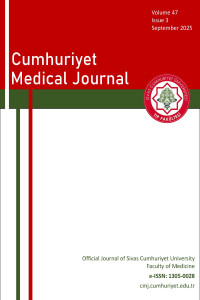Abstract
Subarachnoid hemorrhage is a life-threatening, critical intracranial pathology, typically arising from arterial causes. Subarachnoid hemorrhage is rare and difficult to diagnose due to thrombosis of cerebral venous sinuses. The distribution and treatment of venous SAH differ significantly from aneurysmal SAH. Venous subarachnoid hemorrhage due to Cerebral venous sinus thrombosis is thought to occur due to dilation and rupture of cortical veins in the vicinity of thrombosed venous sinuses. Thalassemia, a hemoglobin production disorder, may cause hypercoagulopathy. This study aims to discuss a case of a patient with β-thalassemia carrier status who developed SAH due to superior sagittal sinus thrombosis.
References
- 1. Leach JL, Fortuna RB, Jones BV, Gaskill-Shipley MF. Imaging of cerebral venous thrombosis: current techniques, spectrum of findings, and diagnostic pitfalls. Radiographics. 2006;26(1):19-41.
- 2. Stam J. Thrombosis of the cerebral veins and sinuses. N Engl J Med. 2005;352(17):1791-1798.
- 3. Ferro JM, Canhao P, Stam J, Bousser MG, Barinagarrementeria F. Prognosis of cerebral vein and dural sinus thrombosis: results of the International Study on Cerebral Vein and Dural Sinus Thrombosis (ISCVT). Stroke. 2004;35(3):664-670.
- 4. Cappellini MD, Poggiali E, Taher AT, Musallam KM. Hypercoagulability in β-thalassemia: a status quo. Expert Rev Hematol. 2012;5(5):505-512. doi:10.1586/ehm.12.42.
- 5. Balasar H, Kocak E. Distinct distribution of HBB variants in two cohorts of beta-thalassemia patients, and a novel variant from Turkey. Mol Syndromol. 2024;15(5):362-370. doi:10.1159/000538300.
- 6. Panda S, Prashantha DK, Ravi SS, Nagaraja D. Localized convexity subarachnoid haemorrhage: a sign of early cerebral venous sinus thrombosis. Eur J Neurol. 2010;17(10):1249-1258.
- 7. Oda S, Shimoda M, Hoshikawa K, Osada T, Yoshiyama M, Matsumae M. Cortical subarachnoid hemorrhage caused by cerebral venous thrombosis. Neurol Med Chir (Tokyo). 2011;51(1):30-36.
- 8. Medeiros FC, Moraes AC, Bicalho ALR, Pinto TVL, Dahy FE. Cerebral venous sinus thrombosis presenting with subarachnoid hemorrhage: a series of 11 cases. Acta Neurol Belg. 2023;123(3):911-916.
- 9. Cortnum S, Sørensen P, Jørgensen J. Determining the sensitivity of computed tomography scanning in early detection of subarachnoid hemorrhage. Neurosurgery. 2010;66(5):900-903.
- 10. Meyer MA. Cerebral sinovenous thrombosis. N Engl J Med. 2001;345(23):1777-1778.
- 11. Wang J, Li JR, Song YL, et al. Clinical characteristics of cerebral venous sinus thrombosis. Neurosciences. 2015;20(3):292-295.
- 12. Kaya D. The diagnosis and treatment of cerebral venous thrombosis. Turk J Neurol. 2017;23(2):94-104.
- 13. Rodallec MH, Krainik A, Feydy A, et al. Cerebral venous thrombosis and multidetector CT angiography: tips and tricks. Radiographics. 2006;26(1):5-18.
- 14. de Bruijn SF, Stam J. Randomized, placebo-controlled trial of anticoagulant treatment with low-molecular-weight heparin for cerebral sinus thrombosis. Stroke. 1999;30(3):484-488.
- 15. Coutinho JM, Ferro JM, Canhao P, Barinagarrementeria F, Bousser MG, Stam J. Unfractionated or low-molecular-weight heparin for the treatment of cerebral venous thrombosis. Stroke. 2010;41(11):2575-2580.
Abstract
Subaraknoid kanama genellikle arterial nedenlerden kaynaklanan hayati tehlike oluşturan önemli bir intrakranial patolojidir. Serebral venöz sinüslerin trombozu nedeniyle subaraknoid kanama gelişmesi nadir görülür ve tanı konulması zordur. Serebral venöz tromboza bağlı gelişen subaraknoid kanamanın dağılım alanı ve tedavisi anevrizmatik kanamadan farklıdır. Serebral venöz sinüs tromobozuna bağlı subaraknoid kanamanın tromboze olmuş venlerin yakın çevresindeki kortikal damarların genişlemesi ve yırtılması nedeniyle geliştiği düşünülmektedir. Talasemi hiperkoagulopatiye yol açabilen hemoglobin yapım bozukluğudur. Bu çalışmada superior sagital sinüs trombozu nedeniyle subaraknoid kanaması olan β Talasemi taşıyıcısı bir hastayı tartışmayı amaçladık.
References
- 1. Leach JL, Fortuna RB, Jones BV, Gaskill-Shipley MF. Imaging of cerebral venous thrombosis: current techniques, spectrum of findings, and diagnostic pitfalls. Radiographics. 2006;26(1):19-41.
- 2. Stam J. Thrombosis of the cerebral veins and sinuses. N Engl J Med. 2005;352(17):1791-1798.
- 3. Ferro JM, Canhao P, Stam J, Bousser MG, Barinagarrementeria F. Prognosis of cerebral vein and dural sinus thrombosis: results of the International Study on Cerebral Vein and Dural Sinus Thrombosis (ISCVT). Stroke. 2004;35(3):664-670.
- 4. Cappellini MD, Poggiali E, Taher AT, Musallam KM. Hypercoagulability in β-thalassemia: a status quo. Expert Rev Hematol. 2012;5(5):505-512. doi:10.1586/ehm.12.42.
- 5. Balasar H, Kocak E. Distinct distribution of HBB variants in two cohorts of beta-thalassemia patients, and a novel variant from Turkey. Mol Syndromol. 2024;15(5):362-370. doi:10.1159/000538300.
- 6. Panda S, Prashantha DK, Ravi SS, Nagaraja D. Localized convexity subarachnoid haemorrhage: a sign of early cerebral venous sinus thrombosis. Eur J Neurol. 2010;17(10):1249-1258.
- 7. Oda S, Shimoda M, Hoshikawa K, Osada T, Yoshiyama M, Matsumae M. Cortical subarachnoid hemorrhage caused by cerebral venous thrombosis. Neurol Med Chir (Tokyo). 2011;51(1):30-36.
- 8. Medeiros FC, Moraes AC, Bicalho ALR, Pinto TVL, Dahy FE. Cerebral venous sinus thrombosis presenting with subarachnoid hemorrhage: a series of 11 cases. Acta Neurol Belg. 2023;123(3):911-916.
- 9. Cortnum S, Sørensen P, Jørgensen J. Determining the sensitivity of computed tomography scanning in early detection of subarachnoid hemorrhage. Neurosurgery. 2010;66(5):900-903.
- 10. Meyer MA. Cerebral sinovenous thrombosis. N Engl J Med. 2001;345(23):1777-1778.
- 11. Wang J, Li JR, Song YL, et al. Clinical characteristics of cerebral venous sinus thrombosis. Neurosciences. 2015;20(3):292-295.
- 12. Kaya D. The diagnosis and treatment of cerebral venous thrombosis. Turk J Neurol. 2017;23(2):94-104.
- 13. Rodallec MH, Krainik A, Feydy A, et al. Cerebral venous thrombosis and multidetector CT angiography: tips and tricks. Radiographics. 2006;26(1):5-18.
- 14. de Bruijn SF, Stam J. Randomized, placebo-controlled trial of anticoagulant treatment with low-molecular-weight heparin for cerebral sinus thrombosis. Stroke. 1999;30(3):484-488.
- 15. Coutinho JM, Ferro JM, Canhao P, Barinagarrementeria F, Bousser MG, Stam J. Unfractionated or low-molecular-weight heparin for the treatment of cerebral venous thrombosis. Stroke. 2010;41(11):2575-2580.
Details
| Primary Language | English |
|---|---|
| Subjects | Medical Education |
| Journal Section | Case Report |
| Authors | |
| Publication Date | September 30, 2025 |
| Submission Date | January 16, 2025 |
| Acceptance Date | August 21, 2025 |
| Published in Issue | Year 2025 Volume: 47 Issue: 3 |

